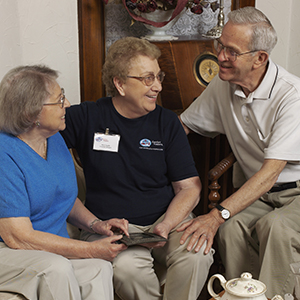Managing Parkinson’s Disease Symptoms
Parkinson’s disease is the second most common neurodegenerative disease in the U.S. after Alzheimer’s disease, and the number of people affected by Parkinson’s is increasing as the population ages.
Parkinson’s disease is the second most common neurodegenerative disease in the U.S. after Alzheimer’s disease, and the number of people affected by Parkinson’s is increasing as the population ages.
Parkinson’s disease can manifest in the following ways:

- Tremors
- Balance problems
- Cognitive impairment
- Mood disorders
- Short steps and slowed movement (bradykinesia)
- Speech and writing changes
While there is no known cure for Parkinson’s, taking steps to manage the disease can increase a senior’s quality of life and help to reduce the impact of symptoms.
Those that have been diagnosed with Parkinson’s should discuss management strategies with a healthcare professional. There are a variety of medications and therapies that a doctor can recommend.
Everyday symptom management strategies can include:
- Finding ways to relieve stress:There is ample evidence that stress can make symptoms worse. However, they usually return to normal levels once the cause of stress is removed. Activities that can help reduce stress include meditation, yoga, deep breathing, getting outside, spending time with loved ones, participating in hobbies or physical activity approved by a physician.
- Maintaining a good diet:For those with Parkinson’s, proper nutrition will not only help manage symptoms, but can help slow the progression of the disease in some seniors. In addition to healthy, nutritious food, it’s important to prevent dehydration too.
- Adapting your home: Depending on the Parkinson’s symptoms that someone is experiencing, there are a variety of ways to improve everyday life with a few adjustments to living space. For those with trouble walking, or those that needs a wheelchair, wide walkways help manage mobility. Mattresses with adjustable features can be helpful for anyone with difficulty getting in and out of bed, and grab bars may be helpful for those with balance issues.
- Preventing falls:Having trouble walking is a common Parkinson’s disease symptom. Minimizing fall risk is an important safety management strategy that is easy to execute. Wearing proper footwear, making sure rooms are properly lit and removing trip hazards can all help reduce the risk of falls.
Comfort Keepers®Can Help
For those who need extra help, in-home caregivers can help facilitate stress management activities, provide support for physician-approved diet and exercise plans and will evaluate a home for safety as part of an in-home assessment. Caregivers can also help with mobility, improve home safety, provide transportation to appointments and events and can help seniors maintain positive mental health through connection, engagement and companionship. For more information on how in-home caregiving can provide assistance to those with Parkinson’s disease, contact your nearest Comfort Keepers® office today.
References
Mayo Clinic. “Parkinson’s Disease.” Web. 2018.
American Parkinson Disease Association. “Living with Parkinson’s Disease.” Web.
WebMD. “Parkinson’s Disease Guide: Living & Managing.” Web.
Parkinson’s Foundation. “Statistics.” Web. 2016.
Sign up to receive helpful info right to your inbox.
We understand choosing an in-home care provider can be a difficult decision, and we want to make your journey as easy as possible. We're here to support you by providing helpful senior care tips and information on in-home care and senior health and wellbeing topics.
Start a Job with a Purpose
Uplifting training and support for you every step of the way.
Apply to be a caregiver






